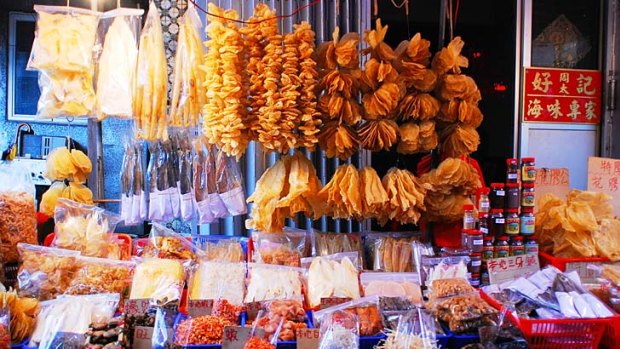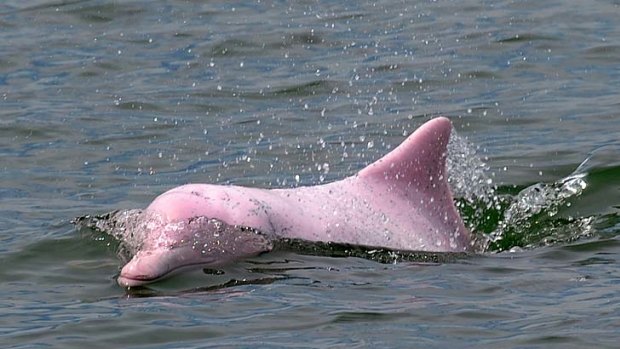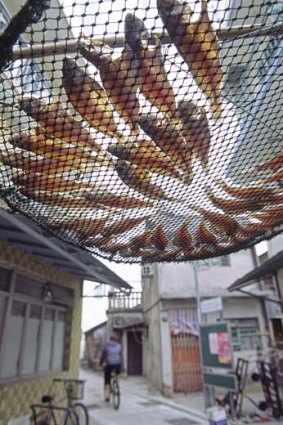
Waterworld... dried seafood for sale at a Tai O stall.Credit: Getty Images
Penny Watson explores a Hong Kong fishing village in whose waters dolphins are still spotted.
'It's a penguin, a penguin," the boy yells as we skim across the water in our boat. I'm twisting my head, this way and that, eyes agog. Penguins in Hong Kong, it can't be? The mistake is amusing and forgivable, English being the second language of this excitable six-year-old, and the reality is almost as unexpected as penguins. Slinking through the water ahead of us is a pod of Chinese white dolphins, their fantastically albino-looking white-and-pink bodies gleaming in the afternoon light.
I am in awe: stories of Chinese white dolphins seem almost apocryphal, such is the rarity of sightings in these overfished local waterways. But here they are, in their natural habitat just 200 metres from shore.

A Chinese white dolphin, nicknamed the pink dolphin, in Hong Kong.Credit: AFP
The locals tell me that sunset - when we happen to be passing by en route from Tai O village to our accommodation - is the best time to see these dorsal-finned cetaceans feasting on fish. I can only assume that day-tripping tourists miss the best window.
I'm staying the night at the newly opened Tai O Heritage Hotel, housed in the former Tai O Police Station; a certainty to become a Hong Kong hot spot given its heritage credentials and its stunning locale on the far-flung western corner of Lantau Island, where a ridge of mountains looms on three sides. Tai O is one of Hong Kong's last remaining fishing villages and one of its oldest. In the 1960s and '70s, 30,000 people lived here, riding the wave of a gung-ho fishing industry that thrived at the mouth of the Pearl River Delta trade route. The demise of the industry, in part brought about by the depletion of the once-prolific yellow croaker fish, saw people leave Tai O for the city.
Today, about 2000 people still call Tai O home. Many are elderly and still ply a small trade in fishing. Tourists that make the 90-minute journey from Central are rewarded with a window into a traditional livelihood. Village life plays out along a wide river channel lined with stilt houses built from wood that gets stronger the longer it stays in the water. On either side of this artery are a labyrinth of laneways where shophouses and galvanised tin dwellings vie for space.

Fish dry above village streets in Tai O.Credit: Getty Images
Dried squid and myriad salted fish, known as haam yue, hang under red shop awnings. Umbrella-topped street carts sell jars of shrimp paste, and baskets brim with unrecognisable sea critters drying in the sun. Barbecues smoke with the smell of grilled prawns, oysters and abalone; today's catch from the wooden boats lined up along the pier. In one of the old temples, huge whale vertebrae are still venerated, with incense and prayer.
It's a 20-minute walk or short boat ride from the village to Tai O Heritage Hotel. From Tai O Bay, the lovely white arched balconies and thick walls of this colonnaded colonial-era building are barely visible through the trees.
At the end of the 19th century this stretch of water, a demarcation line between British and Chinese power in the South China Sea, was rife with pirates and Tai O village was looted on occasion. Built in 1902, the police station was the coast's listening post, the first line of defence for Hong Kong's Victoria Harbour. Hints of its intriguing past welcome me on arrival. Oversize spotlights and two 100-kilogram cannon have been dusted off, repainted and restored to their rightful position at the front of the hotel. At reception, two holding cells with big clunky iron doors are repositories for generations of stories of suspect characters and occasional drunks who spent the night here. Guard towers at each end of the building nod to the station's strategic location, on the southernmost corner of the colony, with a 210-degree line of vision.
The station had 16 police officers and no running water. They would likely marvel at how old offices, the dormitory, kitchen and storeroom are transformed, the hotel now housing nine luxurious suites complete with feather pillows, Molton Brown bath products and marble sinks.
Winnie Yeung, of the Hong Kong Heritage Conservation Foundation, which oversaw the renovation, says every detail has been accomplished without spoiling the integrity of the original buildings. "Even the restaurant with its modern glass and timber roof can be removed without evidence of its existence," she says.
Preserving Tai O culture has been equally high on the agenda, Yeung says. As a non-profit organisation, the foundation has committed to handing over hotel profits to the community, "thereby ensuring its survival". The general public was considered, too. Much of the hotel is open for public viewing by day and restaurant and room rates are reasonable by Hong Kong standards.
My room, in a private corner of the upper level with windows on two sides, is a good example of this egalitarian approach. It is the smallest and cheapest of the hotel's suites but is favoured by returning guests for its view. From the balcony, with its arches, louvered shutters and traditional pitched Chinese clay tile roof, I can see over Tai O Bay. In the morning, I scan the water for more Chinese white dolphins, but I figure it's too early in the day. The penguins aren't up yet either.
FAST FACTS
Getting there
Cathay Pacific has a fare to Hong Kong from Melbourne and Sydney (about 9hr) for about $1270 return, including tax. See cathaypacific.com. From Hong Kong International Airport, take bus route S to Tung Chung (15min), then bus route 11 to Tai O (40min). Alternatively, catch the ferry (www.nwff.com.hk/eng/) from Central Ferry Pier 6 to Mui Wo (40-55min) and take bus route 1 to Tai O (50min). At Tai O, either take the two-minute boat shuttle from the pier near the bus terminus, $HK10 ($1.30), or follow signs for a 20-minute walk to the hotel.
Staying there
Tai O Heritage Hotel has double, "double double" and first- and second-floor suites, from $HK1380 ($182) a night. A culture and experience tour and a sunset boat tour are worthwhile add-ons. See www.taioheritagehotel.com. Tai O is a bus ride away from Hong Kong attractions including Tian Tan Buddha and Ngong Ping 360 scenic cable car.
More information
See discoverhongkong.com.
Sign up for the Traveller Deals newsletter
Get exclusive travel deals delivered straight to your inbox. Sign up now.